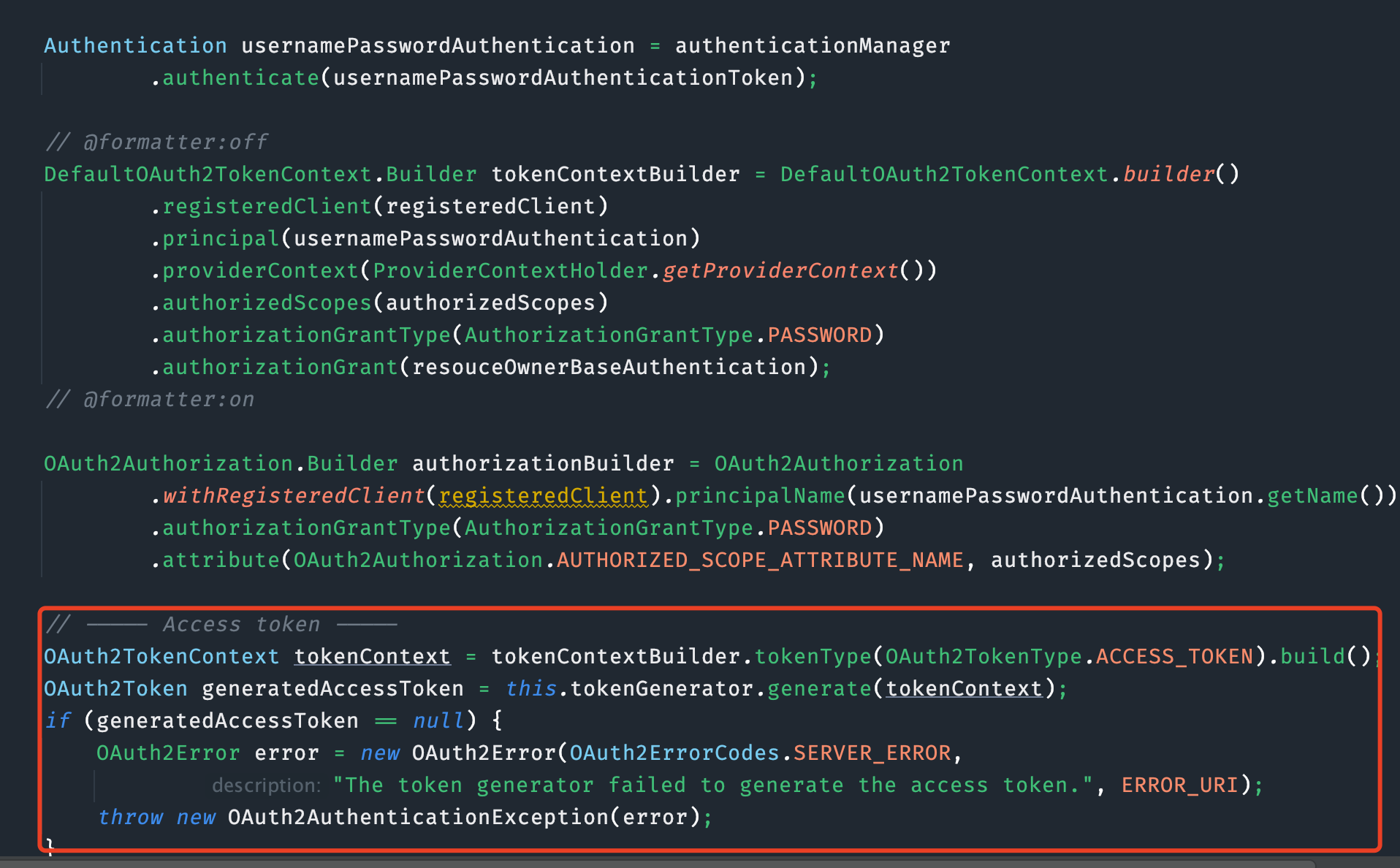Pig4Cloud之登陆验证(二)发放token
上一篇介绍了客户端认证处理,那是令牌颁发的前提。这篇开始,我们就来研究下令牌颁发。
令牌颁发
授权服务器提供令牌颁发接口(/oauth2/token),由客户端发起请求,授权服务器生成访问令牌(access_token)返回,客户端使用此令牌才能去调用资源服务器的接口。
Spring Authorization Server 目前支持如下三种令牌颁发策略:Authorization Code、Client Credentials、Refresh Token,分别对应 授权码模式、客户端凭证模式、刷新令牌模式。
Authorization Code(授权码模式)
客户端访问授权链接,用户授权,客户端获得授权码code,通过code获取令牌
-
传参
- grant_type:固定值 authorization_code
- code:授权码
-
核心类
- OAuth2AuthorizationCodeAuthenticationConverter
- OAuth2AuthorizationCodeAuthenticationProvider
Client Credentials(客户端凭证模式)
- 传参
- grant_type:固定值 client_credentials
- 核心类
- OAuth2ClientCredentialsAuthenticationConverter
- OAuth2ClientCredentialsAuthenticationProvider
Refresh Token(刷新令牌模式)
当客户端支持刷新令牌时,授权服务器颁发访问令牌(access_token)时会同时颁发刷新令牌(refresh_token),客户端可以使用刷新令牌重新获取访问令牌。(由于访问令牌时效比较短,刷新令牌时效比较长,通过刷新令牌获取访问令牌,避免多次授权)
- 传参
- grant_type:固定值 refresh_token
- refresh_token:刷新令牌
- 核心类
- OAuth2RefreshTokenAuthenticationConverter
- OAuth2RefreshTokenAuthenticationProvider
OAuth2TokenEndpointFilter
实现令牌颁发功能的拦截器就是 OAuth2TokenEndpointFilter。OAuth2TokenEndpointFilter 会接收通过上文 OAuth2ClientAuthenticationFilter 客户端认证的请求,其核心代码如下:
@Override
protected void doFilterInternal(HttpServletRequest request, HttpServletResponse response, FilterChain filterChain)
throws ServletException, IOException {
//step1
if (!this.tokenEndpointMatcher.matches(request)) {
filterChain.doFilter(request, response);
return;
}
try {
String[] grantTypes = request.getParameterValues(OAuth2ParameterNames.GRANT_TYPE);
if (grantTypes == null || grantTypes.length != 1) {
throwError(OAuth2ErrorCodes.INVALID_REQUEST, OAuth2ParameterNames.GRANT_TYPE);
}
//step2
Authentication authorizationGrantAuthentication = this.authenticationConverter.convert(request);
if (authorizationGrantAuthentication == null) {
throwError(OAuth2ErrorCodes.UNSUPPORTED_GRANT_TYPE, OAuth2ParameterNames.GRANT_TYPE);
}
if (authorizationGrantAuthentication instanceof AbstractAuthenticationToken) {
((AbstractAuthenticationToken) authorizationGrantAuthentication)
.setDetails(this.authenticationDetailsSource.buildDetails(request));
}
//step3
OAuth2AccessTokenAuthenticationToken accessTokenAuthentication =
(OAuth2AccessTokenAuthenticationToken) this.authenticationManager.authenticate(authorizationGrantAuthentication);
//step4
this.authenticationSuccessHandler.onAuthenticationSuccess(request, response, accessTokenAuthentication);
} catch (OAuth2AuthenticationException ex) {
SecurityContextHolder.clearContext();
this.authenticationFailureHandler.onAuthenticationFailure(request, response, ex);
}
}
step1.判断此次请求是否是 “令牌颁发” 请求,若是,则继续授权模式检验,否则跳过
step2.解析请求中的参数,构建成一个 Authentication(组装登陆认证对象)
step3.认证管理器对 Authentication 进行认证
step4.到这一步说明access_token生成好了, 将access_token和相关信息响应给请求方。
客户端认证 OAuth2ClientAuthenticationFilter 中也正是用的这种实现套路。将不同实现策略抽象为 AuthenticationConverter 和 AuthenticationProvider 接口。每种策略实际上就是一个 AuthenticationConverter 实现类 加上一个 AuthenticationProvider实现类。
组装认证对象
Authentication authorizationGrantAuthentication = this.authenticationConverter.convert(request);
AuthenticationConverter 会根据请求中的参数和授权类型组装成对应的授权认证对象。

授权认证调用
OAuth2AccessTokenAuthenticationToken accessTokenAuthentication =
(OAuth2AccessTokenAuthenticationToken) this.authenticationManager.authenticate(authorizationGrantAuthentication);

在OAuth2ResourceOwnerBaseAuthenticationProvider中

认证逻辑
Authentication usernamePasswordAuthentication = authenticationManager
.authenticate(usernamePasswordAuthenticationToken);
根据认证方法传入的参数判定进入到AbstractUserDetailsAuthenticationProvider
@Override
public Authentication authenticate(Authentication authentication) throws AuthenticationException {
Assert.isInstanceOf(UsernamePasswordAuthenticationToken.class, authentication,
() -> this.messages.getMessage("AbstractUserDetailsAuthenticationProvider.onlySupports",
"Only UsernamePasswordAuthenticationToken is supported"));
String username = determineUsername(authentication);
boolean cacheWasUsed = true;
UserDetails user = this.userCache.getUserFromCache(username);
if (user == null) {
cacheWasUsed = false;
try {
user = retrieveUser(username, (UsernamePasswordAuthenticationToken) authentication);
}
catch (UsernameNotFoundException ex) {
this.logger.debug("Failed to find user '" + username + "'");
if (!this.hideUserNotFoundExceptions) {
throw ex;
}
throw new BadCredentialsException(this.messages
.getMessage("AbstractUserDetailsAuthenticationProvider.badCredentials", "Bad credentials"));
}
Assert.notNull(user, "retrieveUser returned null - a violation of the interface contract");
}
try {
this.preAuthenticationChecks.check(user);
additionalAuthenticationChecks(user, (UsernamePasswordAuthenticationToken) authentication);
}
catch (AuthenticationException ex) {
if (!cacheWasUsed) {
throw ex;
}
// There was a problem, so try again after checking
// we're using latest data (i.e. not from the cache)
cacheWasUsed = false;
user = retrieveUser(username, (UsernamePasswordAuthenticationToken) authentication);
this.preAuthenticationChecks.check(user);
additionalAuthenticationChecks(user, (UsernamePasswordAuthenticationToken) authentication);
}
this.postAuthenticationChecks.check(user);
if (!cacheWasUsed) {
this.userCache.putUserInCache(user);
}
Object principalToReturn = user;
if (this.forcePrincipalAsString) {
principalToReturn = user.getUsername();
}
return createSuccessAuthentication(principalToReturn, authentication, user);
}
查询用户信息

retrieveUser方法
protected abstract UserDetails retrieveUser(String username, UsernamePasswordAuthenticationToken authentication)
throws AuthenticationException;
PigDaoAuthenticationProvider继承了AbstractUserDetailsAuthenticationProvider并重写
retrieveUser方法。返回值为UserDetails。

用户密码校验

PigDaoAuthenticationProvider继承了AbstractUserDetailsAuthenticationProvider并重写
additionalAuthenticationChecks方法。
@Override
@SuppressWarnings("deprecation")
protected void additionalAuthenticationChecks(UserDetails userDetails,
UsernamePasswordAuthenticationToken authentication) throws AuthenticationException {
// app 模式不用校验密码
String grantType = WebUtils.getRequest().get().getParameter(OAuth2ParameterNames.GRANT_TYPE);
if (StrUtil.equals(SecurityConstants.APP, grantType)) {
return;
}
if (authentication.getCredentials() == null) {
this.logger.debug("Failed to authenticate since no credentials provided");
throw new BadCredentialsException(this.messages
.getMessage("AbstractUserDetailsAuthenticationProvider.badCredentials", "Bad credentials"));
}
String presentedPassword = authentication.getCredentials().toString();
if (!this.passwordEncoder.matches(presentedPassword, userDetails.getPassword())) {
this.logger.debug("Failed to authenticate since password does not match stored value");
throw new BadCredentialsException(this.messages
.getMessage("AbstractUserDetailsAuthenticationProvider.badCredentials", "Bad credentials"));
}
}
构建token
认证成功后返回OAuth2ResourceOwnerBaseAuthenticationProvider接着看

CustomeOAuth2AccessTokenGenerator实现OAuth2TokenGenerator接口.
Token 存储持久化


RedisOAuth2AuthorizationService实现OAuth2AuthorizationService
save方法
@Override
public void save(OAuth2Authorization authorization) {
Assert.notNull(authorization, "authorization cannot be null");
if (isState(authorization)) {
String token = authorization.getAttribute("state");
redisTemplate.setValueSerializer(RedisSerializer.java());
redisTemplate.opsForValue().set(buildKey(OAuth2ParameterNames.STATE, token), authorization, TIMEOUT,
TimeUnit.MINUTES);
}
if (isCode(authorization)) {
OAuth2Authorization.Token<OAuth2AuthorizationCode> authorizationCode = authorization
.getToken(OAuth2AuthorizationCode.class);
OAuth2AuthorizationCode authorizationCodeToken = authorizationCode.getToken();
long between = ChronoUnit.MINUTES.between(authorizationCodeToken.getIssuedAt(),
authorizationCodeToken.getExpiresAt());
redisTemplate.setValueSerializer(RedisSerializer.java());
redisTemplate.opsForValue().set(buildKey(OAuth2ParameterNames.CODE, authorizationCodeToken.getTokenValue()),
authorization, between, TimeUnit.MINUTES);
}
if (isRefreshToken(authorization)) {
OAuth2RefreshToken refreshToken = authorization.getRefreshToken().getToken();
long between = ChronoUnit.SECONDS.between(refreshToken.getIssuedAt(), refreshToken.getExpiresAt());
redisTemplate.setValueSerializer(RedisSerializer.java());
redisTemplate.opsForValue().set(buildKey(OAuth2ParameterNames.REFRESH_TOKEN, refreshToken.getTokenValue()),
authorization, between, TimeUnit.SECONDS);
}
if (isAccessToken(authorization)) {
OAuth2AccessToken accessToken = authorization.getAccessToken().getToken();
long between = ChronoUnit.SECONDS.between(accessToken.getIssuedAt(), accessToken.getExpiresAt());
redisTemplate.setValueSerializer(RedisSerializer.java());
redisTemplate.opsForValue().set(buildKey(OAuth2ParameterNames.ACCESS_TOKEN, accessToken.getTokenValue()),
authorization, between, TimeUnit.SECONDS);
}
}
onAuthenticationSuccess

PigAuthenticationSuccessEventHandler实现AuthenticationSuccessHandler
@SneakyThrows
@Override
public void onAuthenticationSuccess(HttpServletRequest request, HttpServletResponse response,
Authentication authentication) {
OAuth2AccessTokenAuthenticationToken accessTokenAuthentication = (OAuth2AccessTokenAuthenticationToken) authentication;
Map<String, Object> map = accessTokenAuthentication.getAdditionalParameters();
if (MapUtil.isNotEmpty(map)) {
// 发送异步日志事件
PigUser userInfo = (PigUser) map.get(SecurityConstants.DETAILS_USER);
log.info("用户:{} 登录成功", userInfo.getName());
SecurityContextHolder.getContext().setAuthentication(accessTokenAuthentication);
SysLog logVo = SysLogUtils.getSysLog();
logVo.setTitle("登录成功");
String startTimeStr = request.getHeader(CommonConstants.REQUEST_START_TIME);
if (StrUtil.isNotBlank(startTimeStr)) {
Long startTime = Long.parseLong(startTimeStr);
Long endTime = System.currentTimeMillis();
logVo.setTime(endTime - startTime);
}
logVo.setCreateBy(userInfo.getName());
logVo.setUpdateBy(userInfo.getName());
SpringContextHolder.publishEvent(new SysLogEvent(logVo));
}
// 输出token
sendAccessTokenResponse(request, response, authentication);
}
输出token
private void sendAccessTokenResponse(HttpServletRequest request, HttpServletResponse response,
Authentication authentication) throws IOException {
OAuth2AccessTokenAuthenticationToken accessTokenAuthentication = (OAuth2AccessTokenAuthenticationToken) authentication;
OAuth2AccessToken accessToken = accessTokenAuthentication.getAccessToken();
OAuth2RefreshToken refreshToken = accessTokenAuthentication.getRefreshToken();
Map<String, Object> additionalParameters = accessTokenAuthentication.getAdditionalParameters();
OAuth2AccessTokenResponse.Builder builder = OAuth2AccessTokenResponse.withToken(accessToken.getTokenValue())
.tokenType(accessToken.getTokenType()).scopes(accessToken.getScopes());
if (accessToken.getIssuedAt() != null && accessToken.getExpiresAt() != null) {
builder.expiresIn(ChronoUnit.SECONDS.between(accessToken.getIssuedAt(), accessToken.getExpiresAt()));
}
if (refreshToken != null) {
builder.refreshToken(refreshToken.getTokenValue());
}
if (!CollectionUtils.isEmpty(additionalParameters)) {
builder.additionalParameters(additionalParameters);
}
OAuth2AccessTokenResponse accessTokenResponse = builder.build();
ServletServerHttpResponse httpResponse = new ServletServerHttpResponse(response);
// 无状态 注意删除 context 上下文的信息
SecurityContextHolder.clearContext();
this.accessTokenHttpResponseConverter.write(accessTokenResponse, null, httpResponse);
}




【推荐】国内首个AI IDE,深度理解中文开发场景,立即下载体验Trae
【推荐】编程新体验,更懂你的AI,立即体验豆包MarsCode编程助手
【推荐】抖音旗下AI助手豆包,你的智能百科全书,全免费不限次数
【推荐】轻量又高性能的 SSH 工具 IShell:AI 加持,快人一步
· Manus重磅发布:全球首款通用AI代理技术深度解析与实战指南
· 被坑几百块钱后,我竟然真的恢复了删除的微信聊天记录!
· 没有Manus邀请码?试试免邀请码的MGX或者开源的OpenManus吧
· 园子的第一款AI主题卫衣上架——"HELLO! HOW CAN I ASSIST YOU TODAY
· 【自荐】一款简洁、开源的在线白板工具 Drawnix